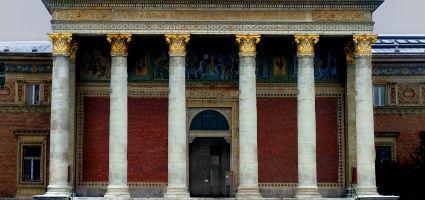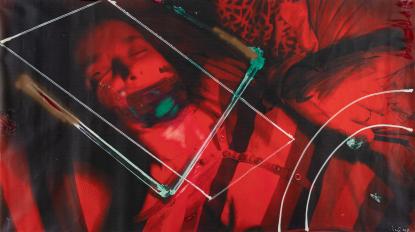2025. October 25. Saturday
Kunsthalle - Budapest
 |
Address: 1146, Budapest Dózsa György út 37.
Phone number: (1) 460-7000, (1) 363-2671
E-mail: info@mucsarnok.hu
Opening hours: Tue-Wed 10-18, Thu 12-20, Fri-Sun 10-18
|
The exhibition has closed for visitors.
2022.04.30. - 2022.10.16.
Museum tickets, service costs:
|
Ticket for adults
|
1200 HUF
|
|
|
Ticket for adults
(valid for the Kunsthalle and the Ernst Museum)
|
1400 HUF
|
|
|
Group ticket for adults
(from over 10 people)
|
800 HUF
|
/ capita
|
|
Ticket for students
(EU citizens from the age of 6 to 26 )
|
600 HUF
|
|
|
Ticket for students
(valid for the Kunsthalle and the Ernst Museum, 6-26 years of age)
|
700 HUF
|
|
|
Group ticket for students
(from over 10 people)
|
400 HUF
|
/ capita
|
|
Ticket for pensioners
(valid for the Kunsthalle and the Ernst Museum, 62-70 years of age)
|
700 HUF
|
|
|
Ticket for pensioners
(EU citizens from the age of 62 to 70)
|
600 HUF
|
|
|
Ticket for families
(1 adults + 2 children)
|
1800 HUF
|
/ family
|
|
Ticket for families
(2 adults + 2 children)
|
2400 HUF
|
/ family
|
István Sinkó’s new series made for this exhibition are unanimously titled Phenomena. In the case of the currently exhibited series visitors are given greater freedom since the artist has not provided a ’solution’ but leaves the interpretation open. Despite the harmonious palette, lyricism and personal tone of the paintings, the works bear the tension created by the subtle opposition of abstraction versus figurative depiction, classical painting versus applied genres. The recognisable forms and motifs are only manifest in the pictorial space as parts of observed visual details and phenomena. The layers, fragments of forms and shadow images create a new perspective or phenomenon, and thus, for example, a found photo becomes a still-life. The tranquillity of the process of observation is perceptible in each work, revealing the painter’s wonderment at the important images of the world and their quality, i.e. at the phenomena that emerge before him. The alternation and changes of colours and forms in this way are evocative of musical improvisation and those with enough experience of registering their exact feelings generated by the phenomena they encounter might even be able to hear the melodies running and winding along them.

István Sinkó’s creative method is characterised by a layered construction, not in the traditional sense but by overlaying genres, methods and processes, thus composing his pictures rendering perceptible the phenomena. His starting point is always a photograph, which we could even call found photos even though the artist always uses his own photographs. They are typically photos of figures, light and shadow phenomena or forms. After enlarging the images into A4 size, the artist ‘works’ the paintings: he adds forms to them or simply enlarges or composes some details. He then takes this version and has a print made of it onto canvas, onto which he applies the final gestures using pastel or spray paint, and thus the picture comes into being. The intellectual content conceived through this method is noteworthy. The underlying idea of photography is the desire to capture facets of reality by using a device, or to represent phenomena as accurately or realistically as possible. In other words, the artist sets a compositional direction – regarding it as a detail of reality, a kind of sketch – and makes it into the starting point for the final work. After developing it further using ’artisan’ tools – i.e. painting into it – he ends up with what can be called a final sketch, which, after being enlarged and printed, becomes the last but one phase of the painting that is exhibited. Then, after the size and composition are finalised, the artist adds certain forms and gestures to create the final balance: the work is thus finished.

István Sinkó’s creative method is characterised by a layered construction, not in the traditional sense but by overlaying genres, methods and processes, thus composing his pictures rendering perceptible the phenomena. His starting point is always a photograph, which we could even call found photos even though the artist always uses his own photographs. They are typically photos of figures, light and shadow phenomena or forms. After enlarging the images into A4 size, the artist ‘works’ the paintings: he adds forms to them or simply enlarges or composes some details. He then takes this version and has a print made of it onto canvas, onto which he applies the final gestures using pastel or spray paint, and thus the picture comes into being. The intellectual content conceived through this method is noteworthy. The underlying idea of photography is the desire to capture facets of reality by using a device, or to represent phenomena as accurately or realistically as possible. In other words, the artist sets a compositional direction – regarding it as a detail of reality, a kind of sketch – and makes it into the starting point for the final work. After developing it further using ’artisan’ tools – i.e. painting into it – he ends up with what can be called a final sketch, which, after being enlarged and printed, becomes the last but one phase of the painting that is exhibited. Then, after the size and composition are finalised, the artist adds certain forms and gestures to create the final balance: the work is thus finished.
